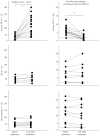Helicobacter pylori-associated immune thrombocytopenia: clinical features and pathogenic mechanisms
- PMID: 24574745
- PMCID: PMC3921481
- DOI: 10.3748/wjg.v20.i3.714
Helicobacter pylori-associated immune thrombocytopenia: clinical features and pathogenic mechanisms
Abstract
Immune thrombocytopenia (ITP) is an autoimmune disease mediated by anti-platelet autoantibodies. There is growing evidence that the eradication of Helicobacter pylori (H. pylori) effectively increases platelet count in a considerable proportion of ITP patients infected with this bacterium. In the majority of ITP patients responding to H. pylori eradication therapy, the anti-platelet autoantibody response is completely resolved with no relapse for more than 7 years, indicating that the disease is cured. Therefore, adult patients with suspected ITP should be examined for H. pylori infection, and eradication therapy is recommended if the infection is present. Notably, however, the efficacy of H. pylori eradication therapy in ITP patients varies widely among countries, with a higher response rate in Japan compared with the United States and European countries other than Italy. The pathogenesis of H. pylori-associated ITP is still uncertain, although the mechanisms are known to involve multiple factors. H. pylori may modulate the Fcγ-receptor balance of monocytes/macrophages in favor of activating Fcγ receptors, and H. pylori components may mimic the molecular makeup of platelet antigens. Further studies of the pathogenic process of H. pylori-associated ITP may be useful for the development of new therapeutic strategies for ITP.
Keywords: Autoantibody; Childhood; Fcγ receptor; Helicobacter pylori; Idiopathic thrombocytopenic purpura; Immune thrombocytopenia; Systemic lupus erythematosus.
Figures

Similar articles
-
Helicobacter pylori Eradication in Patients with Immune Thrombocytopenic Purpura: A Review and the Role of Biogeography.Helicobacter. 2015 Aug;20(4):239-51. doi: 10.1111/hel.12200. Epub 2015 Mar 1. Helicobacter. 2015. PMID: 25728540 Free PMC article. Review.
-
Helicobacter pylori and immune thrombocytopenic purpura: unsolved questions and controversies.Int J Hematol. 2006 Nov;84(4):309-15. doi: 10.1532/IJH97.06188. Int J Hematol. 2006. PMID: 17118756 Review.
-
Effects of a Helicobacter pylori eradication regimen on anti-platelet autoantibody response in infected and uninfected patients with idiopathic thrombocytopenic purpura.Haematologica. 2006 Oct;91(10):1436-7. Epub 2006 Sep 7. Haematologica. 2006. PMID: 16963398
-
Management of Helicobacter pylori in Patients with Immune Thrombocytopenia.Hamostaseologie. 2019 Aug;39(3):279-283. doi: 10.1055/s-0039-1683974. Epub 2019 Mar 19. Hamostaseologie. 2019. PMID: 30891714 Review.
-
Does H. Pylori infection play a role in idiopathic thrombocytopenic purpura and in other autoimmune diseases?Am J Gastroenterol. 2005 Jun;100(6):1271-3. doi: 10.1111/j.1572-0241.2005.50224.x. Am J Gastroenterol. 2005. PMID: 15929756
Cited by
-
Helicobacter pylori and the Human Gastrointestinal Microbiota: A Multifaceted Relationship.Antibiotics (Basel). 2024 Jun 24;13(7):584. doi: 10.3390/antibiotics13070584. Antibiotics (Basel). 2024. PMID: 39061266 Free PMC article. Review.
-
Reference guide for management of adult immune thrombocytopenia in Japan: 2019 Revision.Int J Hematol. 2020 Mar;111(3):329-351. doi: 10.1007/s12185-019-02790-z. Epub 2020 Jan 2. Int J Hematol. 2020. PMID: 31897887 Free PMC article. No abstract available.
-
Helicobacter pylori-Related Extraintestinal Manifestations-Myth or Reality.Children (Basel). 2022 Sep 4;9(9):1352. doi: 10.3390/children9091352. Children (Basel). 2022. PMID: 36138661 Free PMC article. Review.
-
Helicobacter pylori Infection Increased Anti-dsDNA and Enhanced Lupus Severity in Symptomatic FcγRIIb-Deficient Lupus Mice.Front Microbiol. 2018 Jul 6;9:1488. doi: 10.3389/fmicb.2018.01488. eCollection 2018. Front Microbiol. 2018. PMID: 30034379 Free PMC article.
-
Helicobacter pylori infection in the stomach induces neuroinflammation: the potential roles of bacterial outer membrane vesicles in an animal model of Alzheimer's disease.Inflamm Regen. 2022 Sep 5;42(1):39. doi: 10.1186/s41232-022-00224-8. Inflamm Regen. 2022. PMID: 36058998 Free PMC article. Review.
References
-
- Tan HJ, Goh KL. Extragastrointestinal manifestations of Helicobacter pylori infection: facts or myth? A critical review. J Dig Dis. 2012;13:342–349. - PubMed
-
- Stasi R. Immune thrombocytopenia: pathophysiologic and clinical update. Semin Thromb Hemost. 2012;38:454–462. - PubMed
-
- Stasi R, Willis F, Shannon MS, Gordon-Smith EC. Infectious causes of chronic immune thrombocytopenia. Hematol Oncol Clin North Am. 2009;23:1275–1297. - PubMed
-
- Gasbarrini A, Franceschi F, Tartaglione R, Landolfi R, Pola P, Gasbarrini G. Regression of autoimmune thrombocytopenia after eradication of Helicobacter pylori. Lancet. 1998;352:878. - PubMed
-
- Neunert C, Lim W, Crowther M, Cohen A, Solberg L, Crowther MA. The American Society of Hematology 2011 evidence-based practice guideline for immune thrombocytopenia. Blood. 2011;117:4190–4207. - PubMed
Publication types
MeSH terms
Substances
LinkOut - more resources
Full Text Sources
Other Literature Sources
Medical

